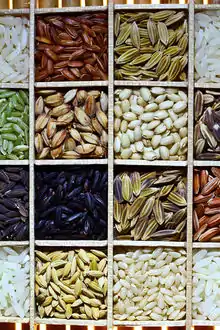List of Five grains in world culture
Five grains, traditional set phrase for lists or groupings which may contain non-grain crops.[1] Particular instances of Five grains of a single crop or other substance such as minerals and metals have historical or cultural significance as well.[2]

Rice grains showing diversity

Bi'ur Chametz, burning to remove five Chametzgrains during an annual Jewish festival period
Five grains may refer to:
East Asia
- Five Cereals (China), various lists of the most important cultivated crops assigned since the earliest mythological times in Chinese cuisine, farming, and civil and spiritual culture[1]
- Baijiu liquor, whose varieties include Five Grains Liquid (Wuliangye, 五 粮 液)
- Korean cuisine (section Grains), in whose myths deities brought seeds of five grains
- Ogokbap, five-grains rice in Korean cuisine
- A group of crops in Japanese cuisine and spiritual culture whose guardian is Ukanomitama no kami, a spirit to whom Kasama Inari Shrine is dedicated, and which are honored with a Five Grains Garden in Manyo Botanical Garden, Nara
West Asia
- Pas Yisroel, "Bread of an Israelite" which discusses "the five classical grains of Judaism" in Rabbinical tradition, including the grain Emmer
- Matzo or Matzah, unleavened cracker bread in Jewish cuisine regarding which "There are five grains that may not be used during Passover in any form except for Matzah"; see also Chametz
- Chametz (section The five grains), leavened or leavenable grains and their flours in Jewish cuisine which are taboo during certain festival periods in Jewish tradition; see also Matzo
- Five grains of musk are included with Cubeb (section Uses, subsection Medicinal) in an aphrodisiac recipe in The Book of One Thousand and One Nights popularly known in English as the Arabian Nights
Europe
- Five grains of incense are used in the course of Christian religious Dedication, (section Medieval Western customs) of altars and sacred places, as with Exsultet Easter Proclamation and the use of the Paschal candle
Atlantic
- "Five grains of corn," the daily ration of starving settlers from Europe traveling by ship in search of New World settlement, a tradition of Christian Thanksgiving lore [3]
Mesoamerica
Chemistry
- Using Grain (unit), a 325mb tablet of aspirin is sometimes referred to as "five grain aspirin."
- "Five grains of gold" are used in such European formulae as that for the gilding of buttons, where they are used in an amalgam of mercury[5]
- The chemical specification of Coyoteite, NaFe3S5·2H2O, which was performed by electron microprobing of five grains of this mineral
References
- Sarah Milledge Nelson, Origins of Food Production In China - Rice, Millet Cultivation, Other Domesticated Plants, Domesticated Animals, Oryza sativa, Children of the Yellow Earth, mian. With bibliography. http://www.jrank.org/history/pages/5913/Origins-Food-Production-In-China.html
- Erd, Richard C.; Czamanske, Gerald K. (1983). "Orickite and coyoteite, two new sulfide minerals from Coyote Peak, HunboldtCountry, California". American Mineralogist 68: 245–254,
- Adoro Te Devote
- http://www.greatdreams.com/mayan/mayan-games.htm
- The Family magazine, or, Monthly abstract of general knowledge, Volume 2, 1837 CE, p. 413
This article is issued from Wikipedia. The text is licensed under Creative Commons - Attribution - Sharealike. Additional terms may apply for the media files.